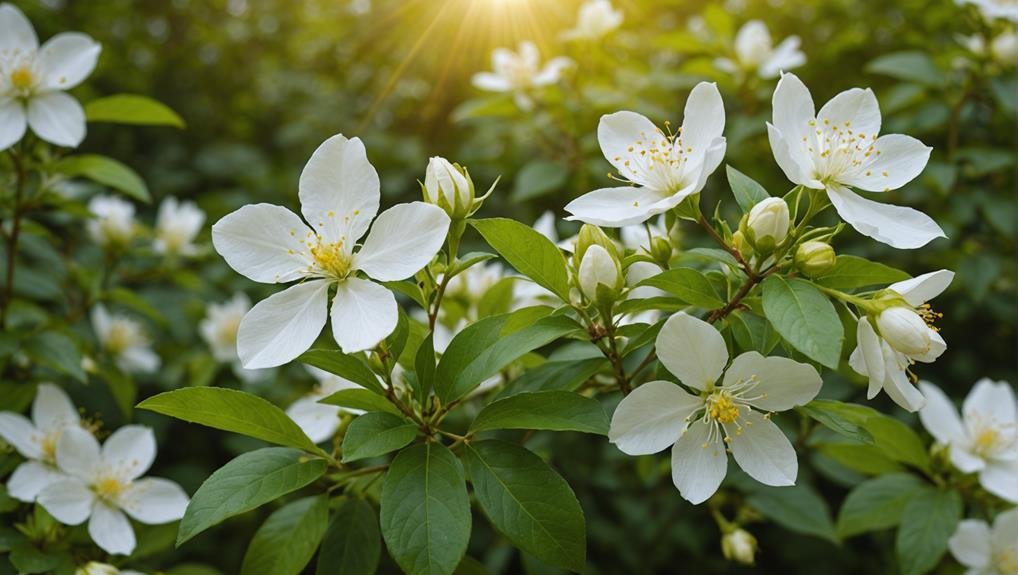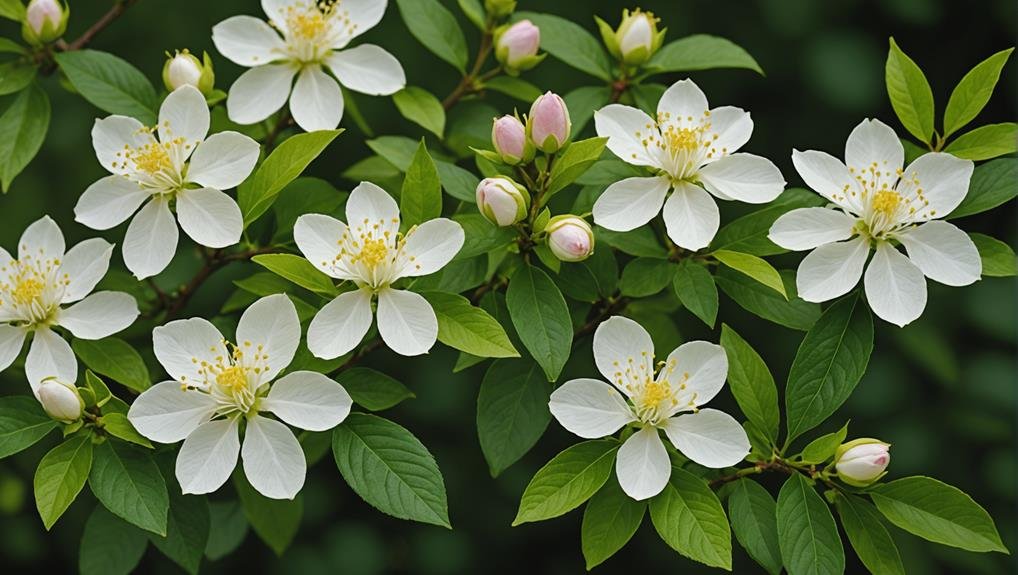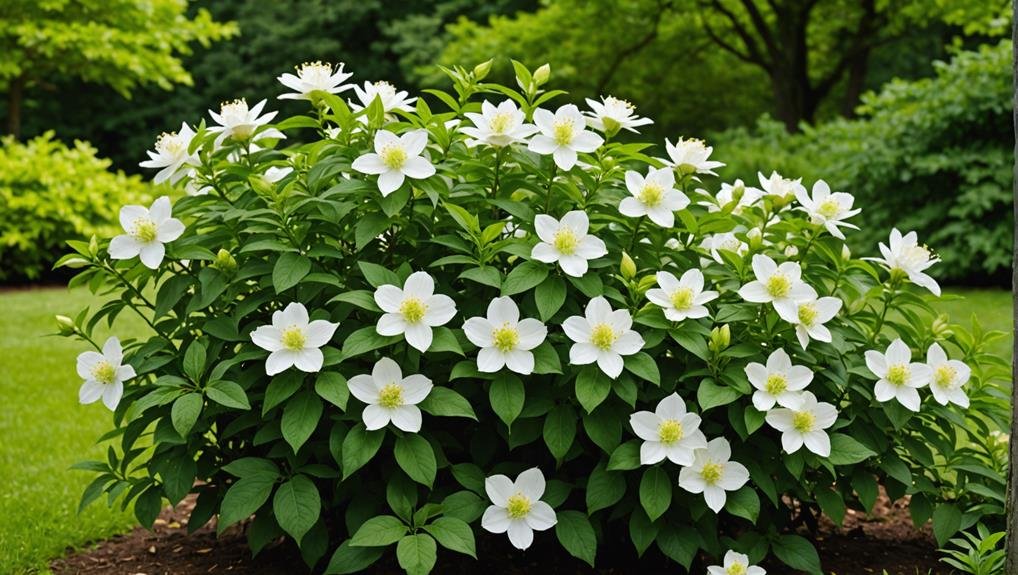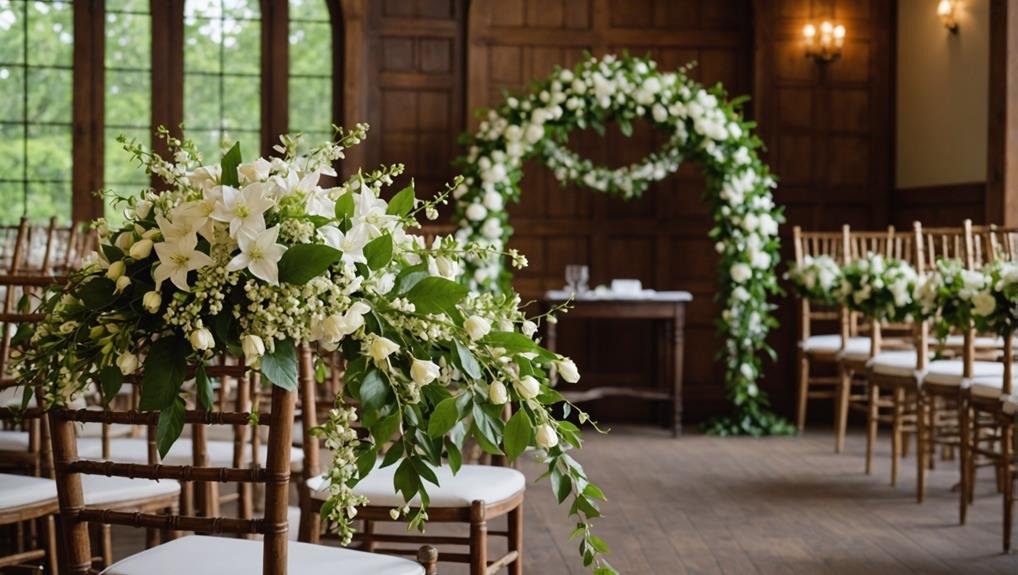The Mock Orange flower, renowned for its delicate white blooms and enchanting citrus-like fragrance, has become a cherished element in wedding floral arrangements. With its symbolism of innocence and new beginnings, it perfectly complements the theme of matrimony. This article will explore the various aspects of Mock Orange—from its physical characteristics and color variations to its geographical origins and cultural significance. As we navigate through its myriad uses in wedding decor, one might ponder how this elegant bloom has maintained its timeless appeal in modern nuptials.
Flower Overview

Renowned for their white blossoms and sweet citrus fragrance, Mock Orange flowers symbolize innocence and purity, making them a cherished choice for wedding ceremonies. These fragrant flowers are highly favored due to their symbolic representation of new beginnings, love, and happiness, key elements in any matrimonial celebration.
Mock Orange flowers are often incorporated into various wedding elements, such as bridal bouquets, centerpieces, and floral arrangements. Their elegant appearance and enchanting aroma provide a romantic and charming touch to the event, enhancing the overall ambiance. The presence of these fragrant flowers in wedding décor not only elevates the aesthetic appeal but also contributes to a memorable sensory experience for the attendees.
Furthermore, gifting Mock Orange flowers is a traditional gesture signifying good luck, joy, and a strong bond between the couple. This practice underscores the flower's association with positive matrimonial attributes, making it a thoughtful and meaningful gift for newlyweds.
Physical Description
Mock Orange flowers are characterized by small, white, highly fragrant blooms that grow on shrubs with dark green foliage. These flowers, known for their citrus-like scent, evoke the aroma of orange blossoms, making them a delightful addition to any wedding bouquet or floral arrangement.
The Mock Orange shrubs themselves serve as a lush backdrop for the delicate blooms. The shrubs are robust, featuring dark green leaves that contrast beautifully with the pristine white flowers. Each bloom is typically cup-shaped, comprising multiple delicate petals that create a soft and elegant appearance.
The flowers are not only visually appealing but also highly fragrant, a quality that adds a sensory dimension to wedding decor. The scent of Mock Orange flowers is both fresh and invigorating, often described as reminiscent of citrus or orange blossoms. This fragrance can permeate a space, enveloping guests in a subtle yet memorable aroma.
Mock Orange shrubs are valued in the floral industry, particularly for weddings. Their combination of striking white flowers and lush green foliage makes them versatile for various floral designs, from bouquets to centerpieces. The elegance and fragrance of Mock Orange flowers ensure they remain a popular choice for nuptial celebrations.
Available Colour Varieties

While the pristine white blooms of Mock Orange are most commonly sought after for weddings, there are subtle variations in color that can also be found among different species. The default and most popular choice remains the white flower, symbolizing innocence and purity—an ideal match for the theme of new beginnings that weddings often embody. This classic and elegant appearance has made the white Mock Orange a staple in wedding floral arrangements.
However, some varieties of Mock Orange offer blooms with a hint of cream or a faint yellow undertone. These slight deviations from the traditional white can provide a unique touch to floral designs, catering to those seeking a subtle variation while maintaining the flower's timeless elegance. The cream-colored variations, though less common, add a soft, romantic touch, ideal for creating a warm, inviting atmosphere at wedding ceremonies and receptions.
Despite these nuances, white remains the predominant color choice due to its universal appeal and symbolic significance. The ability of Mock Orange flowers to blend seamlessly with other floral elements makes them a versatile and valuable addition to any wedding décor, ensuring they remain a favored choice for couples and florists alike.
Latin Name and Taxonomy
Philadelphus, the Latin name for Mock Orange, derives from the Greek words 'phileo' (to love) and 'adelphos' (brother), underscoring a theme of brotherly love. Mock Orange belongs to the Hydrangeaceae family, a group celebrated for its diverse and ornamental members. Taxonomically, the genus Philadelphus comprises approximately 60 species of deciduous shrubs. These species are renowned for their fragrant, white blooms that grace gardens and wedding bouquets alike.
The genus Philadelphus includes both single and double-flowered varieties, each bringing its unique charm and aromatic presence to floral arrangements. The flowers typically blossom in late spring to early summer, providing a delightful sensory experience. The diverse species within this genus offer a range of sizes and forms, making them versatile for various landscaping and decorative purposes.
Mock Orange is favored in wedding settings for its symbolic meanings of innocence, purity, and love. This symbolic significance, combined with its aesthetic appeal, makes Philadelphus a preferred choice for bridal bouquets and other floral decorations. By understanding the taxonomy and Latin nomenclature of Philadelphus, one can appreciate the rich heritage and botanical significance that this popular plant brings to special occasions.
Geographical Origins

Understanding the geographical origins of Mock Orange enhances our appreciation of its diverse applications in wedding traditions across different cultures. Native to regions in Asia, North America, and Europe, Mock Oranges (Philadelphus) are found in countries such as China, Japan, the United States, and various European nations. These shrubs thrive in a range of climates, from temperate to subtropical regions, showcasing their adaptability and resilience.
The widespread geographical distribution of Mock Oranges has led to the development of numerous cultivated varieties, each adapted to specific growing conditions. This diversity not only enriches the plant's aesthetic appeal but also contributes to its symbolic and cultural significance in wedding ceremonies worldwide. The table below highlights the geographical origins and climates where Mock Oranges flourish:
| Region | Countries | Climate Types |
|---|---|---|
| Asia | China, Japan | Temperate, Subtropical |
| North America | United States | Temperate |
| Europe | Various Nations | Temperate, Subtropical |
Understanding the provenance of Mock Orange helps us appreciate its role in wedding traditions, where it symbolizes purity and sweetness. The adaptability of this charming shrub secures its place in diverse cultural contexts, adding a touch of natural beauty to wedding celebrations across the globe.
Season Availability
Mock Orange flowers are most readily available during the spring and early summer months, making them an ideal choice for weddings held in these seasons. This period aligns with their peak blooming season, typically occurring in late spring. As a result, couples planning spring weddings can easily incorporate these charming flowers into their floral arrangements.
During these months, Mock Orange flowers are accessible from a variety of sources, including florists and nurseries. Their high availability guarantees that wedding planners and brides have an ample selection to choose from, allowing for a seamless integration into bouquets, centerpieces, and other decorative elements.
However, it is important to note that availability may vary depending on the region. Different geographical areas may experience slight variations in blooming periods, which can affect the supply of Mock Orange flowers. It is advisable for couples and event planners to consult with local florists to confirm availability during their specific wedding dates.
Growing Conditions

To ensure the abundant availability of Mock Orange flowers for spring and early summer weddings, it is vital to understand the best growing conditions for these versatile shrubs. Mock Orange bushes thrive in full sun, which is essential for optimal growth and blooming. While they can tolerate partial shade, full sun exposure guarantees the most abundant and vibrant flowers, making them ideal for wedding arrangements.
Well-drained soil is necessary for Mock Orange plants, and they demonstrate a wide pH tolerance, meaning they can adapt to various soil types. Securing proper watering is crucial; although these shrubs are relatively low-maintenance, they benefit from consistent moisture, especially during dry spells. Mulching around the base of the plant helps retain soil moisture and suppress weeds, contributing to healthier growth.
Fertilization should be done in the spring with a balanced fertilizer to promote robust flowering. Regular pruning after the flowering period is necessary to shape the shrub and encourage new growth, ensuring continuous bloom production.
With these care practices, Mock Orange shrubs will remain healthy and vibrant, providing a stunning display for any wedding setting. Their adaptability and low-maintenance nature make them an excellent choice for wedding florists and gardeners alike.
Cultural Significance
Celebrating the cultural significance of Sweet Mock Orange flowers reveals their rich symbolism and importance in wedding traditions. These delicate blooms have long been associated with purity, innocence, and the promise of new beginnings, making them a desirable choice for wedding bouquets.
Their historical symbolism of deceit has evolved over time to embody sibling love and familial bonds, adding layers of meaning to their use in matrimonial ceremonies.
The cultural significance of Sweet Mock Orange flowers extends to their representation of love, happiness, and the start of a new chapter. The pristine white color and sweet fragrance of these flowers contribute to their timeless appeal, symbolizing unity and eternal love.
Incorporating Sweet Mock Orange flowers into wedding celebrations often signifies blessings and good wishes for the couple's future together.
To summarize the cultural significance:
- Symbolism: They represent purity, innocence, and new beginnings.
- Evolution: Historical deceit symbolism now signifies sibling love and familial bonds.
- Wedding Significance: They convey love, happiness, and the start of a new chapter.
Gifting Sweet Mock Orange flowers during weddings encapsulates the essence of everlasting love and unity, ensuring their continued popularity in wedding bouquets and arrangements.
Typical Use in Weddings

Building on their rich cultural significance, Sweet Mock Orange flowers are meticulously chosen for their prominent role in wedding ceremonies. These flowers are renowned for their symbolism of new beginnings and love, making them an ideal choice for weddings. Their pristine white color represents innocence and purity, attributes highly cherished in matrimonial celebrations. Brides and event planners frequently select Mock Orange for bridal bouquets, centerpieces, and various floral arrangements due to their elegant and classic appearance.
The sweet citrusy scent of Mock Orange adds a romantic and fragrant touch to wedding decor, enhancing the overall ambiance of the event. Whether incorporated into elaborate floral displays or as subtle accents, these blossoms elevate the aesthetic appeal of wedding settings. Their versatility allows them to blend seamlessly with other floral elements, contributing to a cohesive and harmonious decor.
Here is a table summarizing the typical uses of Mock Orange in weddings:
| Use Case | Description |
|---|---|
| Bridal Bouquets | Symbolizes purity and love, adds grace and fragrance. |
| Centerpieces | Enhances table settings with classic and romantic charm. |
| Floral Arrangements | Used in various decor elements for a unified look. |
| Ceremony Decor | Adds a touch of purity and innocence to the venue. |
| Scents | Infuses a sweet, citrusy aroma into the wedding atmosphere. |
Mock Orange's timeless appeal guarantees it remains a favorite choice in wedding florals.
Alternative Flower Types
When planning a wedding, exploring alternative flower types can offer unique and personalized floral arrangements that reflect the couple's style and theme. While mock orange blossoms are popular for their delicate appearance and enchanting fragrance, delving into various other flower options can bring a distinct flair to your wedding decor.
For a traditional wedding look, ponder using roses, lilies, or peonies. These classic flowers exude elegance and timeless beauty. Alternatively, sunflowers, dahlias, or hydrangeas can introduce a vibrant and colorful touch to the arrangements. These blooms are especially appealing for summer weddings.
For a rustic and charming ambiance, integrating wildflowers, baby's breath, or lavender can be an excellent choice. These flowers add a natural, carefree feel to the decor. Additionally, tropical flowers such as orchids, hibiscus, or bird of paradise can infuse an exotic vibe into the wedding setting, perfect for beach or destination weddings.
When selecting blooms, it's also wise to contemplate seasonal options for a cohesive and budget-friendly theme. Here are three key points to remember:
- Spring: Tulips and daffodils bring fresh, vibrant colors.
- Summer: Sunflowers and dahlias add warmth and brightness.
- Fall: Chrysanthemums and marigolds offer rich, autumnal hues.
